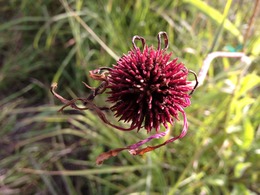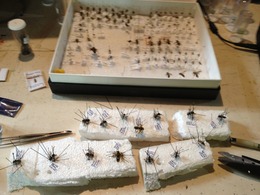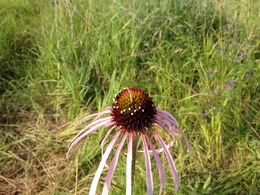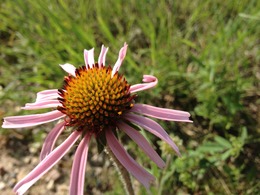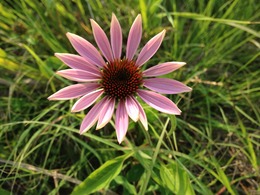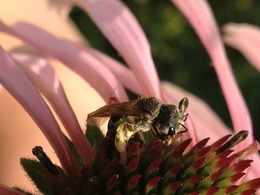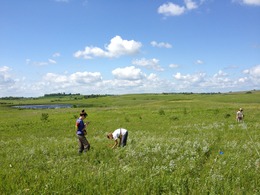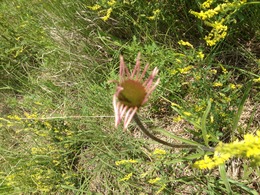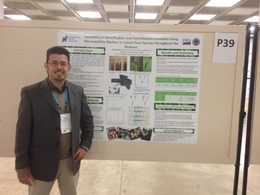After leaving June first to the Societyy of Wetland Scientists conference at Duluth, MN, I am definitely returning to the coolest city in this country “My sweet home Chicago” today. It has been a very interesting and special summer for me. I have had tons of good experiences. I certainly had the best experiences in the Star of the North (Minnesota). Specifically, with the Echinacea Project. Thanks guys of the Echinacea team 2013, Gretel, Stuart, and family.
On August 26th, Marie and me had the opportunity of sharing our respective research in the Field Museum of Chicago. We found a very receptive audience for the Echinacea project. I had good amount of very interesting questions. Overall, people liked the fact that several students have been working in research that complement each other. This is the case of Shona in 2012 with Marie and me in 2013.
Now, I am preparing to present this research again in my university symposium on September 20th and as a poster presentation at the SACNAS National conference at San Antonio TX next on October 4th.
Again, Thank you very much to everybody who is or has been part of this fascinating enterprise called the Echinacea project
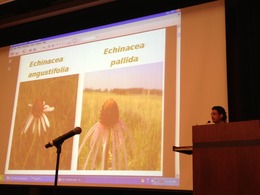
|
||||
|
Today, we pollinated flowers in the common garden during the entire morning. Afternoon we kept pollinating with simultaneous phenology in the same garden. Due to last night stormy weather, most of us could not keep collecting data as in previous days. Marie could not measure her plants; Kory and I did not observe as many pollinators as normally we do. Only Sarah B. maintained her data collection immutable. Consequently, I went to the Hjelm house to start pinning the pollinators that I have been collecting since Sunday. After Jennifer and Stuart explained the principles of pinning insects, I could pinned fourteen of the twenty one insect collected during this week. Definitely, it will facilitate identification of pollinators enormously. Personally, this week was a very revealing week for me since I had the opportunity of witness the presence of the three species of echinacea in this region. Since my research involve the interaction among these species of echinacea, I have been very involved in observe the flowering and the location of the different species in this area. Thus, introduced Echinacea pallida started flowering (White pollen) at the Hegg Lake on Sunday while native angustifolia did the same on Tuesday (Yellow pollen).
Echinacea pallida started flowering on Sunday. Since then I have been able to observe, collect, and film the different species of insects that pollinate this plant. It has been such a wonderful experience to work surrounded by the beautiful landscape of the Hegg Lake Wildlife Management Area. I am so excited to start getting data that will elucidate the real possibilities of hybridization between Echinacea pallida and Echinacea angustifolia.
Perfect weather! Just like my home country (beautiful). Today morning, we searched for Stipa grass and flowering Echinacea (My favorite task) in the common garden. Afternoon, we searched for more Stipa grass. Then, we worked in our projects. Marie received a scan and starting playing with it. Lydia continued her work with aphids. I received my cameras and started practicing the difficult art of insect hunting. Kory was preparing his cameras to identify pollinators, and Sara B. was checking status of plants in several sites of the area. We ended the day eating a delicious chili prepared by Ilse. I am an undergraduate student from Northeastern Illinois University (NEIU). Although I was born and raised in Venezuela (South America), I consider the American Midwest my home. Due to the high degree of anthropogenic disturbances in this region, I am very interested in studying its ecology. Particularly, I am interested in the effect that invasive species and habitat fragmentation has in native species and communities As an independent project, I will determine the likelihood of hybridization between echinacea angustifolia and echinacea pallida (maybe purpurea too)in nature. In order to do that, I will have to determine if there is synchrony between them and at what level this different species of plants share pollinators. It will promise to be an interesting and wonderful summer for me in this beautiful state. |
||||
|
© 2025 The Echinacea Project - All Rights Reserved - Log in Powered by WordPress & Atahualpa |
||||

